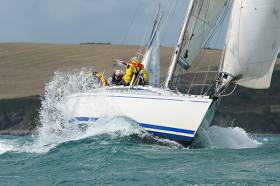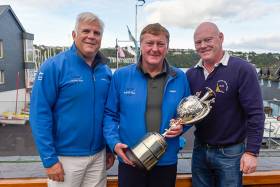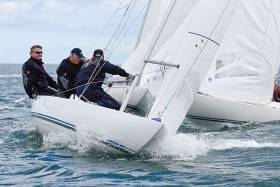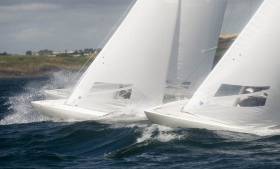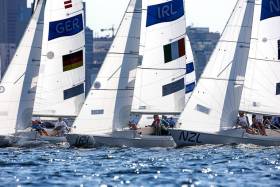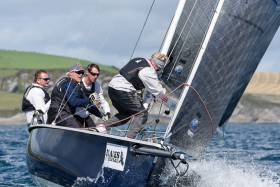Displaying items by tag: Kinsale Yacht Club
Squib Traveller Trophy Goes to Kinsale Yacht Club Duo
Jeff Condell and Jeff Cochrane from Kinsale Yacht Club sailing In Squib 812 'Fuggles' are the winners of this year's Irish Squib Travellers Trophy.
The annual keelboat class award is for Squibs which travel to the regional and national championships.
It is necessary to compete in two regional championships and in the National Championships to qualify to win the trophy.
They concluded their achievement with a 3rd place at the inland championships in Dromineer on Lough Derg last weekend.
Kinsale Sailing Cruisers Turnout for 'At Home' Regatta (PHOTO GALLERY)
There was a great turnout for Kinsale Yacht Club's 'At Home' Regatta yesterday. The all–in IRC 2016 cruiser fleet attracted 19 entries and was won by Richard Hanley's GK24 Saoirse. In a 41–boat ECHO handicap division the win went to an Elan 333, Artful Dodger, skippered by Finbarr O'Regan.
The main feature of this year's 'At Home' was the upsurge of new Oppie sailors who started sailing at KYC this season. Unfortunately, KYC’s sailability fleet was stood down due to a heavy airs forecast although some sailors later went to sea in a Hawk 20. During the day a large squall with rain went through and this put a lot of the beginner Oppy sailors out of action. KYC is suffering a shortage of cruiser racers, like many other clubs, and this was evident in the spinnaker class turnout. The Squibs mustered four boats but one retired before racing.Royal St. George Jaguar Team Wins Dragon Nationals in Kinsale
A single point margin gave Jaguar sailed by Martin Byrne, Adam Winkelmann and Donal Small the Irish Dragon title in Kinsale this afternoon. The RStGYC entry best local hope Cameron Good, Henry Kingston, David Good and Simon Furney sailing 'Little Fella' in a seven race series.
Royal St. George boats took three of the top four places in the 12–boat fleet. Cloud sailed by Clare Hogan, Neil Hogan, Bill Nolan and Graeme Grant took third overall beating defending champions Phantom David Williams, Arthur Meighan, Hilary Murray and Ed Butler in fourth overall.
Despite the relatively small turnout, it was a very hard fought contest. Going into the final race both Good and Byrne were on equal points but to win Good had to beat Byrne and finish in the top six. It was not to be and the first five overall were only separated by a point each (22–26 points)Royal St. George's Jaguar Leads Dragon Nationals in Kinsale
Royal St. George's Jaguar sailed by Martin Byrne, Adam Winkelmann and Donal Small lead the Cantor Fitzgerald Dragon National Championships at Kinsale Yacht Club after three races sailed writes Bob Bateman. The Dun Laoghaire crew lead by four points from Kinsale locals Cameron Good Henry Kingston/ David Good Simon Furney who were winners of the Glandore based South coast championshps held a fortnight ago. Third is Byrne's club mate Clare Hogan skippering Cloud on equal points with Good's Little Fella. Racing continues tomorrow. Full results sheet downloadable below.
Racing Abandoned At Dragon National Championships, Kinsale Due to Fog
After a one hour postponement at the Dragon National Championships the decision was taken to abandon today's first day of racing due to fog and light winds writes Bob Bateman in Kinsale. The first gun tomorrow is scheduled for 11.55.
Twomey, Costelloe & O'Carroll Move Into Top Ten At Paralympic Regatta
On the third day of the Rio Paralympic sailing regatta, Ireland's John Twomey from Kinsale Yacht Club with crew Ian Costelloe and Austin O'Carroll are back into the top ten overall after counting a fifth in race six of the three person Sonar keelboat class. Ireland scored also scored a 9th and 13th yesterday moving them up to tenth overall. Full results here.
Race day three. Three people in a boat. Three races. Three wins. If three isn't the lucky number for Great Britain's Robertson, Stodel and Thomas then it certainly should be after today.
Languishing in the bottom half of the fleet with a 11,9,14 on the scorecard it looked like the chase for a medal was over before it had begun for the British team. Whatever went on in the nightly debrief after day two, it definitely worked.
Not giving too much away, Thomas said, "Some of the stuff we talked about last night in the debrief we came out on the water today and implemented.”
He continued, "The debrief from last night was mainly to believe. Which then allowed us to follow our plan. So believe and then execute with a positive mindset. We love the medium to strong breeze and we have been working on a few techniques with our new coach which are working.”
If the team is to continue up the leaderboard and get a first Paralympic medal in their fourth attempt, they will need a lot more of that belief that worked so well, but they also need boats around them to falter. For Thomas though, their destiny is still in their own hand's, "All we have to do is worry about our own performance and not worry about the others. Having three firsts makes you feel positive and I'm not sure how that has helped us with the overall scores. The boat is going well now, and we can't influence others.
"For us it is about sticking to our processes and coming out strong and delivering on what we can do. If we can then be in the medal zone we will be happy.”
The Britons now sit in fifth place on 23 points.
Still leading the way are the Australian team of Colin Harrison, Russell Boaden and Jonathan Harris who posted two second places and a discarded seventh for the day to leave the team on 12 points. They are followed in second by 2016 world champions Alphonsus Doerr, Hugh Freund and Bradley Kendell (USA) who rocketed up from seventh place with a 2,3,3 to finish on 18 points.
New Zealand's Richard Dodson, Andrew May and Chris Sharp are third on 21 points with London 2012 bronze medallists, Norway's Aleksander Wang-Hansen, Marie Solberg and Per Eugen Kristiansen just one point back on 22.
Twomey & Crew Start Sonar Paralympic Regatta in Rio
Ireland's Paralympic sailing team secored a ten and 14 in the first two rounds of the three person keelboat regatta yesterday. Kinsale Yacht Club's Sonar crew of John Twomey, Ian Costelloe and Austin O'Carroll now lie 12th from 14 with two more races in the series today and plenty of opportunity for a prized top ten finish. Results are here.
With compatriot Matt Bugg going well in the 2.4 Norlin OD and the SKUD18 team leading the way in their fleet, it was down to Colin Harrison, Russell Boaden and Jonathan Harris to carry the baton for Australia in the Sonar to end a good day for the land down under.
The Australians led at every mark on the Escola Naval race area in race one to take the bullet and followed it up with a second place to sit on top of the leaderboard with three points.
Explaining the key to success for his team, Harrison said, "It was about getting a clear lane early, focusing on boat speed and then just working the shifts. It wasn't tough in that they were huge shifts but there was enough pressure and you had to be on the right side of it.”
Even with the good start, Harrison knows the battle for gold won't be an easy one with top competition to deal with as well as difficult race areas, "It's very challenging racing in Rio, out of all the venues we have sailed around the world in the Sailing World Cup series, Rio is the most challenging.”
Recovering from an eighth place in race one, Trans-Tasman neighbours, New Zealand's Richard Dodson, Andrew May and Chris Sharp, came back with a bullet in race two to move up to second overall on nine points.
New Zealand may be the second name on the leaderboard, but they sit on the same points as Vasilis Christoforou, Anargyros Notaroglou and Thodoris Alexas (GRE) who scored a 3,6 and Lasse Klötzing, Siegmund Mainka and Jens Kroker (GER) who scored a 4,5.
World champions, USA's Alphonsus Doerr, Hugh Freund and Bradley Kendell have ten points which leaves them in sixth overall while Canada's Paul Tingley, Logan Campbell and Scott Lutes are above them in fifth on the same points tally.
Racing continues on Tuesday 13 September with two races scheduled for all fleets. There will be a switch in the race areas as the 2.4 Norlin OD and SKUD18 race on the Escola Naval area and Sonar's move to the Pao de Acucar (Sugarloaf Mountain) race area.
Kinsale Yacht Club's 'Little Fella' is Dragon South Coast Champion
Dragons from the Dun Laoghaire, Kinsale and UK fleets joined the large Glandore Harbour Yacht Club fleet for the Irish South Coast Championships last weekend.
Racing began on Friday in a fresh 15–knot breeze when International Race Officer, Alan Crosbie, added a third race to the schedule because of expected gales on Saturday.
Defending champion, Cameron Good sailing "Little Fella" from Kinsale, started well with two race wins and a third. David Williams in "Phantom" from the Royal St George YC was consistent ending their day with a 2,3,2.
Martin Byrne's "Jaguar Sailing Team" recovered well to finish 5th in race one but only after returning to the start line to pick up Adam Winkelmann who fell overboard after their first tack and got separated from the boat. The Royal St George YC sailors followed that drama with a 2nd and 1st to lie a close third overall at the end of day one.
On Friday evening Glandore Harbour Yacht Club, who now have the largest Dragon Fleet in Ireland, hosted an excellent reception for the competitors in their Clubhouse by the harbour.
 Martin Byrne's "Jaguar Sailing Team" recovered well to finish 5th in race one but only after returning to the start line to pick up Adam Winkelmann who fell overboard
Martin Byrne's "Jaguar Sailing Team" recovered well to finish 5th in race one but only after returning to the start line to pick up Adam Winkelmann who fell overboard
Saturday morning brought the expected gales and huge waves so Alan Crosbie made an early decision to cancel racing for the day. This allowed the competitors to enjoy the delights of West Cork in various locations from Skibereen to Schull and Baltimore before the championship dinner in Glandore village later that evening.
The expected forecast of 10 to 12 knots did not materialise on Sunday and the fleet of 17 Dragons had to wait until 1230hrs before race 4 started in a very light breeze. This turned out to be the only race of the day ahead of a deadline of 1400hrs. It turned out to be a competitive race with regular place changes in the shifting breeze.
With no discard coming into play the podium positions were all up for grabs and "Little Fella", "Jaguar" and "Phantom" finished 1st, 2nd & 3rd overall after keeping a close covering eye on each other in very a tactical race.
However it was Patrick Gifford, sailing "Basilisk" GBR 515, from Aldeburgh Yacht Club who won this race easily after leading at the top mark to move up and take 4th overall. Anthony O'Neill sailing "Tenacious" and Adrian Bendon in "Mar J", both from Kinsale were 5th & 6th overall.
The Dragon fleet remain on the South Coast for their National Championships which take place in Kinsale in two weeks time.
1720 Championship Victory for Peter O'Leary's 'Dutch Gold' in Kinsale
After missing out on Day 2 of the 1720 Irish championship entirely due to inclement weather, OOD Peter Crowley and his team were on the water at Kinsale before 09:00 this morning and managed to complete a full programme of races for the 1720 National Championships writes Peadar Murphy. The wind today was light and shifting, but four highly competitive races were still squeezed in and had everyone ashore just before the rain swept in again.
After the first four races on Friday, Anthony O’Leary on “Antix” led from the Byrne and Wilson outfit on “ZING” and Aoife English on “Atara”. However today, the next generation of O’Learys shot to the fore on “Dutch Gold” (newly arrived from Holland!) with Peter on the helm and Robert midship providing the fleet with a masterclass in 1720 sailing in light airs. Three bullets and a second place finish rightly crowning them as the 1720 National Champions for 2016 and bringing the title to Baltimore Sailing Club, capping off a memorable week for that part of the world!
Though never quite at the front of the fleet today, Padraig Byrne and Don Wilson on “ZING” had done enough on Friday to ensure that their lesser results today still merited a second place overall. The lighter airs today seemed to suit a number of boats that hadn’t been quite in the running in strong stuff on Friday; Fionn Lyden on Baltimore Sailing Club boat “Live Wire” had a strong showing today, and might have been pushed a bit by fellow Baltimore boat “Smile n’ Wave”, though their challenge ran out of steam later in the day. Also prominent today were Paul Gibbons’ “Wahoo” and Dun Laoghaire visitor Kenneth Rumball on “Team INSS”. However, despite an off day today - Anthony O”Leary’s “Antix” came home in third overall with five points to spare over “Wahoo”.
However, the undoubted winner of the Blacks of Kinsale 1720 National Championships was Peter O’Leary.
O'Leary Leads Kinsale–Based 1720 National Championships (Photo Gallery HERE)
After four races of the 1720 National Championships at Kinsale YC in County Cork this afternoon, Antix, skippered by Anthony O'Leary of Royal Cork, leads the 16–boat fleet by two points writes Bob Bateman.
Races were sailed in a 15-knot south westerly with Antix, the current 1720 European champion, counting two wins and two seconds. O'Leary's RCYC club mates Padraig Byrne & Don Wilson are second on eight points. In third place is Howth Yacht Club and Royal Cork entry Altara skippered by Aoife English on 21 points.
Fomer Euro champion boat MICAM skippered by Mel Collins from Baltimore SC was sixth in race one but sustained gear failure and did not compete in the next three.
Friday dawned dull and with light breezes for the 16-boat fleet of the Blacks of Kinsale 1720 National Championships. OOD Peter Crowley on “Sparetime” head south to roughly one mile south of Centrepoint and laid a course to the southwest over to Black Head. The first of three scheduled races got underway with the sun starting to break through the cloud and the promise of a great day’s sailing.
Race 1 quickly established the running order for the day, with Anthony O’Leary on “Antix” and the Padraig Byrne & Don Wilson team on “ZING” coming in first and second. By the time the second race started, the sun was well established and the wind had built up. Aoife English on “Atara” scored the sole bullet of the day not taken by “Antix” or “ZING’, but had both hot on her heels. Baltimore boats "Live Wire” and “MICAM” suffered issues during the race and neither finished the race, with “MICAM”’s broken lower spreader proving terminal to her racing for the day.
For Race 3, “Live Wire” were back in business, but Denis Murphy’s “Aquatack” were not in a position to start, denting what was otherwise shaping up to be a good day’s scoring for the RCYC boat. Another perennial front-of-fleet boat - Clive O’Shea’s and Tom Durcan’s “T-Bone” was another victim of conditions in Race 3 with “ZING” scoring her sole bullet of the day. With the sun bright in the sky, strong and steady winds and a forbidding forecast for Saturday, OOD Peter Crowley elected to run a fourth race.
Fans of full-blasting were served up a treat with boats screaming down the run on the plane, with plenty of hairy gybes and more than a few broaches and wipeouts. “T-Bone” didn’t make it to the finish for their second race in a row, and “Wahoo” from RCYC also having an off race for them with a DNF dropping them from a potential third place overall at the halfway point of the championship. “Antix” and “Zing” continued to lead the way, with O’Leary claiming the final bullet of the day. Crews returned to the marina in Kinsale with broad grins, sore limbs and more than a few ripped sails and damaged lines. The marina looked reminiscent of a team garage at a Formula 1 race as efforts were made to ready the boats for what lies ahead...
Provisional results below.





























